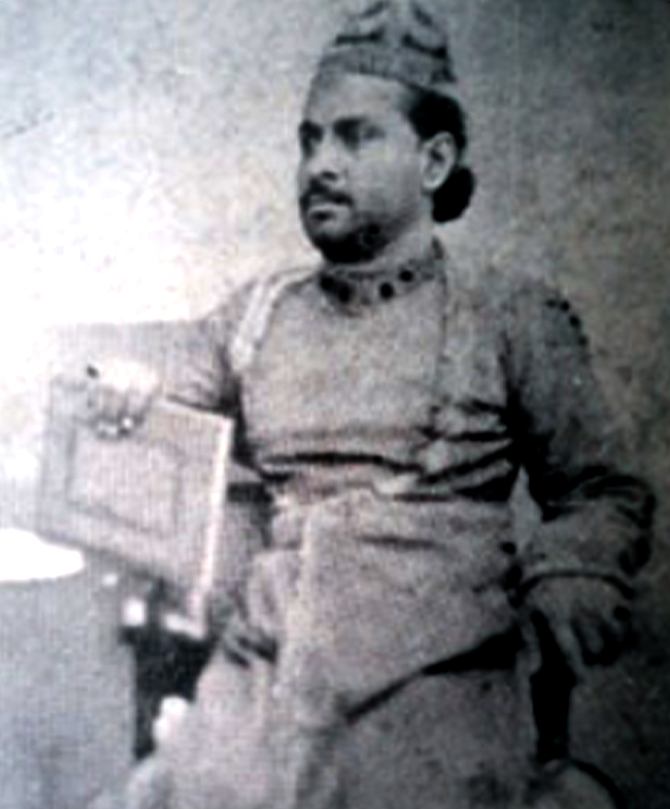History
The foundation stone of the library was laid by Raja Gulal Narayan Singh
The Gopal Narayan Public Library, Bharatpura fits the description. Bharatpura village, situated on the main road, some twenty-five kilometers from the Bihta hermitage of Sahajanand Saraswati, the founder of the Kisan Sabha. Green farmlands encompass the scene on entering the village.and between the vast lands of vegetation, stands the building of the library on a high mount, carefully guarded by the security guards.
Like the library, the village of Bharatpura itself, has its own historical importance. The founder of the library, Late Gopal Narayan Singh was a descendant of a very wise and brave king, Raja Kanhchand. Raja Kanhchand had adopted Raja Gulalchand as his son. His family had migrated to Bihar from the state of Maharashtra, during the reign of the Mughal emperor Shahjahan. Raja Kanhchand had a good reputation in the court of the emperor. Later on, Mughal emperors Farukhshiyar and Shah Alam bestowed upon him the title of Raja Sahab. His son, Raja Bharat Singh, built a fort in Rampur Mohkam which later on became popular as Bharatpura Garh.

The foundation stone of the library was laid by Raja Gulal Narayan Singh in the latter half of the 19th century. His son Babu Gopal Narayan Singh gave the library its present form on 12th December, 1912. During those pre-independence days, illiteracy was rampant among the Indians. This made the foundation of the library all the more significant. The library was inaugurated by the then District Collector, WDR Prentice. Two years later the then Commissioner, Mr. CA Oldham attended the Foundation Day of the library. He expressed his wonder in these words: "I visited the G. N. Library with the Collector of Patna and have been greatly interested in looking through the collection of old books and painting. The library is kept very tidy and it is a pleasure to be shown round it by Babu Gopal Narayan Singh to whom the collection due and who evidently takes the keenest interest in it."
By offering his magnificent building decorated with various articles, Late Lal Narayan Singh showed the magnanimity of his heart. Unfortunately, the building of the library was reduced to shackles in an earthquake in 1934. This disrupted any further progress of the library. The credit of preserving the invaluable articles of the library goes to Late Raghuraj Narayan Singh. In the foundation day ceremony on 18th March, 1949, presided over by Late Dr. Anugrah Narayan Singh, it was felt that the library must be declared pubic. This thought was materialized by Late Raghuraj Narayan Singh by the means of a registered deed of gift in the year 1956. According to this, an executive committee was planned for the proper functioning of the library.
It was established that a suitable member of the donator family and the sub-divisional officer would be appointed as the Secretary and the President of the committee respectively. A special committee to be presided over by the District Magistrate of Patna was also proposed. The Secretary was supposed to run the library in consultation with the executive committee. After the death of Shri Raghuraj Narayan Singh, the post of the Secretary was taken over by his son, Dhrupad Narayan Singh.
The library boasts of having a collection of published books, more than five thousand illustrated manuscripts, a thousand rare pictures, ancient sculptures and hundreds of coins, including those of the Pal period. Some of the most important ones include Shahnama, written in 1009 AD by Abul Qasim Mansural Firdausi Altusi. It recounts Persia's history and culture. Full of paintings, the book contains sixty thousand poems. Another is Sikandarnama which contains magnificent paintings. The calligraphy of Sikandarnama, too, is excellent. The pages have golden borders all around. There are also very rare and unique collection of vaslis a beautiful example of calligraphy.
Akbar's court painter Basawan's painting Sadhu is a proud possession of this library. It is sketched on a white paper in black ink. Basawan is a world-renowned painter whose works can be found in museums and art galleries in Kolkata, New York, Oxford and London. Besides more than five thousand illustrated manuscripts and thousand rare paintings of the Mughal era, there are hundreds of ancient coins stored in this library. In addition to these, the Persian versions of Shivpuran, Ramayan of Tulsidas, Singhasan Battisi, Hatimtai, Mahatripursundaripatlam, Mahabharat on Palm leave etc. are also there. Manuscripts in Sanskrit, Pali, Prakrit and Hindi can also be found here. Some of the important ones are Srimad Bhagwatam, Narsinghapuran, Bhavishyapuran, Uttargita, Jyotisharatnamala, Vinaypatrika, Geet Govind and Geetavali.